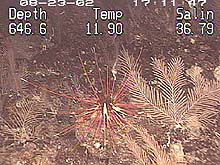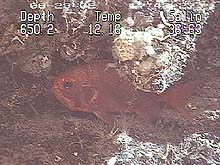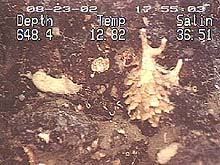Charleston Bump, Lumps, and Humps, Oh My!
August 24, 2002
Paula Keener-Chavis, National Education Coordinator/Marine Biologist
NOAA Office of Ocean Exploration
![]() Watch a video of lunar-like scenery and a snowy grouper swimming under a ledge. (mp4, 1.5 MB)
Watch a video of lunar-like scenery and a snowy grouper swimming under a ledge. (mp4, 1.5 MB)
"I have made friends with the sea; it has taught me a great deal. There is a kind of inspiration in the sea. When one listens to its never-ceasing murmur afar out there, always sounding at midnight and mid-day, one’s soul goes out to meet Eternity." -- L.M. Montgomery
Having finished the explorations at Site 1, the Seward Johnson headed for Site 2, an area known as ‘Charleston Bump,’ where ledges and rocky outcrops, called the Charleston Lumps, can be found at depths from 500 to 700 feet. Preliminary investigations report that this area, which flanks the western edge of the Blake Plateau, has a great deal of invertebrate growth – sponges, hydroids, and corals – that thrive on the rock ledges forming low pinnacles. The area has never been explored for organisms that are known to produce bioactive compounds.
We arrive at the site just after midnight on August 23rd, and the mission of the first dive is to “run to the target site in 685 feet of water, making collections along the way, and select a site for the traps to be deployed during Dive 2. The crystal blue ocean water so characteristic of Site 1 has turned a greenish-blue color, indicating much higher turbidity in the water and it may indicate that the site is much more productive than Site 1. Much to everyone’s surprise, on the first dive the Johnson-Sea-Link approaches a seascape that looks exactly like the landscape of the moon! All that can be seen is sand and a few large rocks scattered haphazardly here and there. Videotapes recorded during the dive confirm that the shadow of the submersible as it approaches the bottom is, in fact, the lunar landing revisited!
Over the next two days, the light-tight traps are baited and deployed and catch hagfish and two crabs. Dr. Tammy Frank’s electrophysiology experiment with which she is measuring the spectral sensitivity of crustacean eyes indicates that one of the crabs has extremely sensitive eyes. Her experiment ran for two hours and then shorted out. Dr. Edie Widder reports that her ‘Eye’ (referring to the Eye-in-the-Sea camera) is no better. In fact, she jests that the ‘patient’ is in a coma and she is considering brain surgery…in other words, ‘reprogramming the computer.’
Submersible dives over rises and low lying areas continue to yield sample collections and video recordings of beautiful corals, sponges, holothuroideans, crabs, sea stars, and sea urchins. Several snowy grouper, (Epinephelus niveatus), scorpaenids (red, spiny fishes), small rattails, and a few small sharks have been caught on film. A small plankton net catches planktonic organisms that bioluminescence and some very interesting larval fishes – at least 15 families of fishes are represented by the larvae , which can fit easily in a large tablespoon.
Dr. Shirley Pomponi has collected a sponge she has never seen before at this site. We call it the ‘Christmas tree’ sponge and another interesting sponge that looks like a snowball lying on the ocean floor has also been collected here. It would be nice to stay longer, but this evening we depart for Site 3. Stay tuned.
Identification of the Orange Roughy in the image above was made by Michael S. Taylor; Ph.D. student, marine ichthyology; Louisiana State University.
Sign up for the Ocean Explorer E-mail Update List.

















































